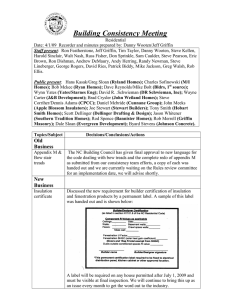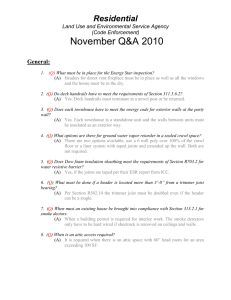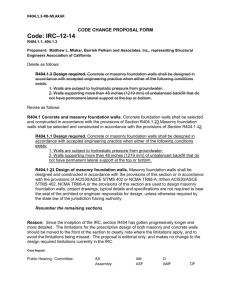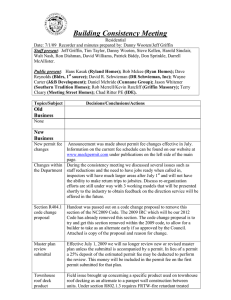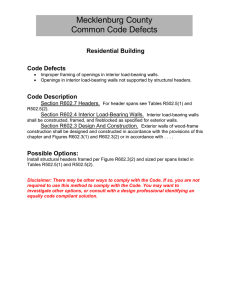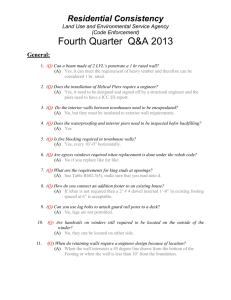Building Consistency Meeting
advertisement
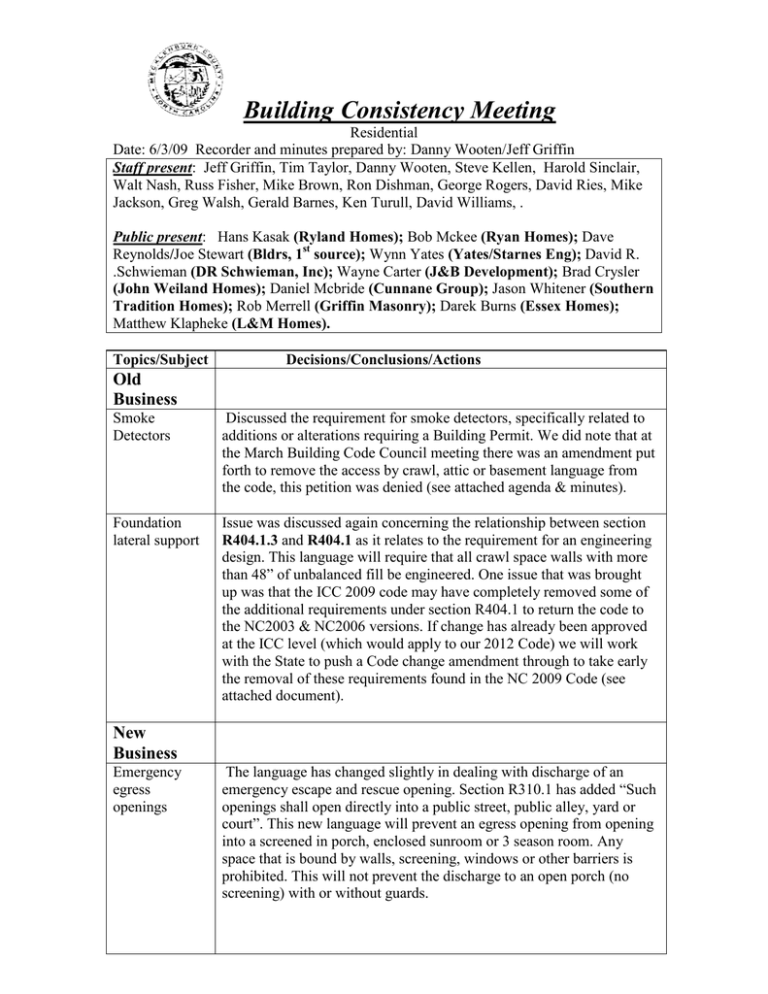
Building Consistency Meeting Residential Date: 6/3/09 Recorder and minutes prepared by: Danny Wooten/Jeff Griffin Staff present: Jeff Griffin, Tim Taylor, Danny Wooten, Steve Kellen, Harold Sinclair, Walt Nash, Russ Fisher, Mike Brown, Ron Dishman, George Rogers, David Ries, Mike Jackson, Greg Walsh, Gerald Barnes, Ken Turull, David Williams, . Public present: Hans Kasak (Ryland Homes); Bob Mckee (Ryan Homes); Dave Reynolds/Joe Stewart (Bldrs, 1st source); Wynn Yates (Yates/Starnes Eng); David R. .Schwieman (DR Schwieman, Inc); Wayne Carter (J&B Development); Brad Crysler (John Weiland Homes); Daniel Mcbride (Cunnane Group); Jason Whitener (Southern Tradition Homes); Rob Merrell (Griffin Masonry); Darek Burns (Essex Homes); Matthew Klapheke (L&M Homes). Topics/Subject Decisions/Conclusions/Actions Old Business Smoke Detectors Discussed the requirement for smoke detectors, specifically related to additions or alterations requiring a Building Permit. We did note that at the March Building Code Council meeting there was an amendment put forth to remove the access by crawl, attic or basement language from the code, this petition was denied (see attached agenda & minutes). Foundation lateral support Issue was discussed again concerning the relationship between section R404.1.3 and R404.1 as it relates to the requirement for an engineering design. This language will require that all crawl space walls with more than 48” of unbalanced fill be engineered. One issue that was brought up was that the ICC 2009 code may have completely removed some of the additional requirements under section R404.1 to return the code to the NC2003 & NC2006 versions. If change has already been approved at the ICC level (which would apply to our 2012 Code) we will work with the State to push a Code change amendment through to take early the removal of these requirements found in the NC 2009 Code (see attached document). New Business Emergency egress openings The language has changed slightly in dealing with discharge of an emergency escape and rescue opening. Section R310.1 has added “Such openings shall open directly into a public street, public alley, yard or court”. This new language will prevent an egress opening from opening into a screened in porch, enclosed sunroom or 3 season room. Any space that is bound by walls, screening, windows or other barriers is prohibited. This will not prevent the discharge to an open porch (no screening) with or without guards. Residential sprinklers Question asked about the status of residential sprinkler system (13D) in new home construction. The Building Code Council has not addressed this issue at this time and would have to start probably some time in mid 2010 to role out in the 2012 Codes. There may be a proposal back before ICC in the 2009/2010 code development cycle that could affect the outcome of what the State does with sprinkler systems in residential single family homes. We will continue to monitor any proposals made to ICC and advise of any changes at the State level. Plan Review deadlines Deadline for residential plan submittal using the 2006 was June 12th, 2009. All plans will need to be submitted at this time based upon the issuance of a new permit under the NC 2009 residential building Code. The Department is in the middle or a re-organization effort to include both office and field staffing. Several options are currently being discussed among task force committee members, made up of both staff and industry representation. How services might be delivered in the future will be discussed at the next consistency meeting along with dates for public meetings on these efforts will be announced. Department re-organization Stud spacing Table Question asked about the maximum stud height allowed under the code. Table R602.3(5) indicates a maximum of 10’ for all bearing situations and longer lengths for non-bearing. The text in R602.3.1 would indicate that as well with 2 exceptions noted. Please note that the reference in the text under R602.3.1 to Table R602.3.1 is an error that will be posted shortly by the State as an errata. The correct listing should be “Table R602.3 (5)”. There is an allowance for some areas in the State of NC to use Table R602.3.1 for longer lengths of studs in bearing walls but it was also noted that the footnote applications will limit the areas this table can be used (see footnote b under table R602.3.1). Proposal made at the March 2009 BCC meeting dealing with smoke detectors Item B – 3 Request by Robert Privott, NC Home Builders Association, to amend the 2009 NC Residential Code. The proposed amendment is as follows: R313.2.1 Alterations, repairs and additions. When alterations, repairs or additions requiring a building permit occur, or when one or more sleeping rooms are added or created in existing dwellings, the individual dwelling unit shall be equipped with smoke alarms located as required for new dwellings; the smoke alarms shall be interconnected and hard wired. Exceptions: 1. Interconnection and hard-wiring of smoke alarms in existing areas shall not be required where the alterations or repairs do not result in the removal of interior wall or ceiling finishes exposing the structure, unless there is an attic, crawl space, or basement available which could provide access for hard-wiring and interconnection without the removal of interior finishes. 2. Work involving the exterior surfaces of dwellings, such as the replacement of roofing or siding, or the addition or replacement of windows and doors, or the addition of a porch or deck, are exempt from the requirements of this section. BCC vote: Item B – 3 Request by Robert Privott, NC Home Builders Association, to amend the 2009 NC Residential Code. The proposed amendment is as follows: R313.2.1 Alterations, repairs and additions. When alterations, repairs or additions requiring a building permit occur, or when one or more sleeping rooms are added or created in existing dwellings, the individual dwelling unit shall be equipped with smoke alarms located as required for new dwellings; the smoke alarms shall be interconnected and hard wired. Exceptions: 1. Interconnection and hard-wiring of smoke alarms in existing areas shall not be required where the alterations or repairs do not result in the removal of interior wall or ceiling finishes exposing the structure, unless there is an attic, crawl space, or basement available which could provide access for hard-wiring and interconnection without the removal of interior finishes. 2. Work involving the exterior surfaces of dwellings, such as the replacement of roofing or siding, or the addition or replacement of windows and doors, or the addition of a porch or deck, are exempt from the requirements of this section. Motion – David Smith/Second – Alan Perdue/Denied – The Petition was denied. This item was sent to the Residential Committee for review. ____________________________________________________________________ Foundation issues R404.1.3 Design required. Concrete or masonry foundation walls shall be designed in accordance with accepted engineering practice when either of the following conditions exists: Item #2- Item #2 creates an issue with foundation tables 2. “Walls supporting more than 48 inches (1219 mm) of unbalanced backfill that do not have permanent lateral support at the top and bottom”. R404.1 Foundation and retaining walls. Foundation walls that meet all of the following shall be considered laterally supported: 1. Full basement floor shall be 3.5 inches (89 mm) thick concrete slab poured tight against the bottom of the foundation wall. 2. Deleted. 3. Bolt spacing for the sill plate shall be no greater than 36 inches (914 mm). 4. Deleted. 5. Where foundation walls support unbalanced load on opposite sides of the building, such as a daylight basement, the building aspect ratio, L/W, shall not exceed the value specified in Table R404.1(3). For such foundation walls, the rim board shall be attached to the sill with a 20 gage metal angle clip at 24 inches (610 mm) on center, with five 8d nails per leg, or an approved connector supplying 230 pounds per linear foot (3.36 kN/m) capacity. Issue according to R404.1.3 the Foundation tables in Chapter 4 cannot be used if more than 48” of unbalanced fill unless they meet the requirements of R404.1. Conclusions: • Foundations (basements or crawl) that have 48” or less of unbalanced fill or less only have to meet the base foundation anchor requirements of section R403.1.6 of 1’ off corners and every 6’ o.c. spacing and the specific lateral support requirements listed in R404.1 do not apply. • Foundations (basement or crawl) that have more than 48” of unbalanced fill must meet all the requirements of R404.1 unless engineered. Problem is that there is a slab requirement against the base of a basement wall and nothing for the typical crawl space applications. So a slab would need to be poured in a crawl or and engineer would be required for crawl space walls with more than 48” of unbalanced fill since not lateral supported at the bottom end. Option is needed for crawl space walls to prescriptively use tables above 48” of unbalanced fill, this could be added to item #1 or item #2 could address the issue.
